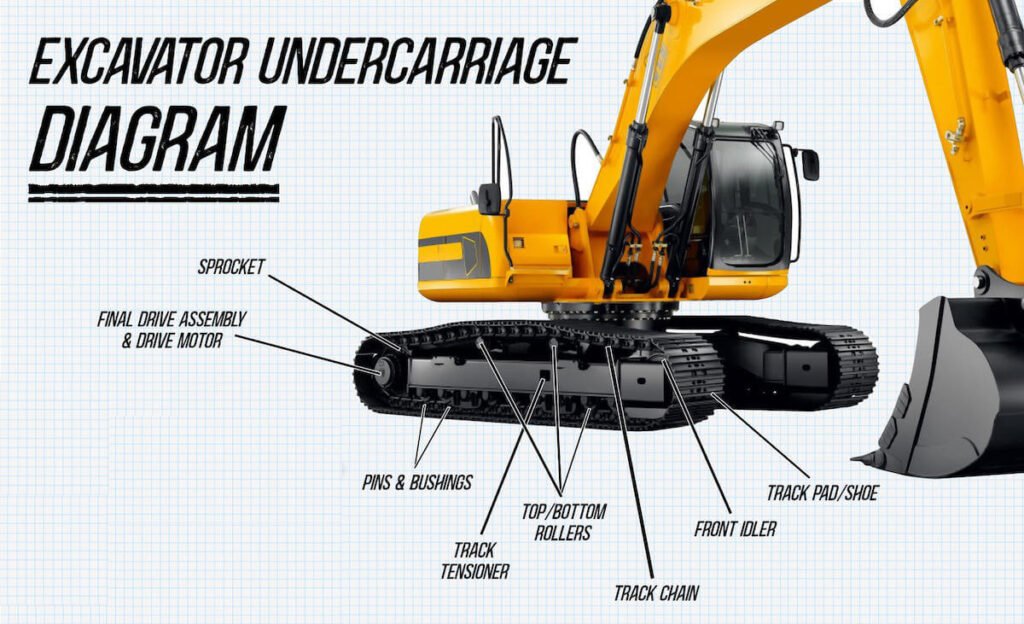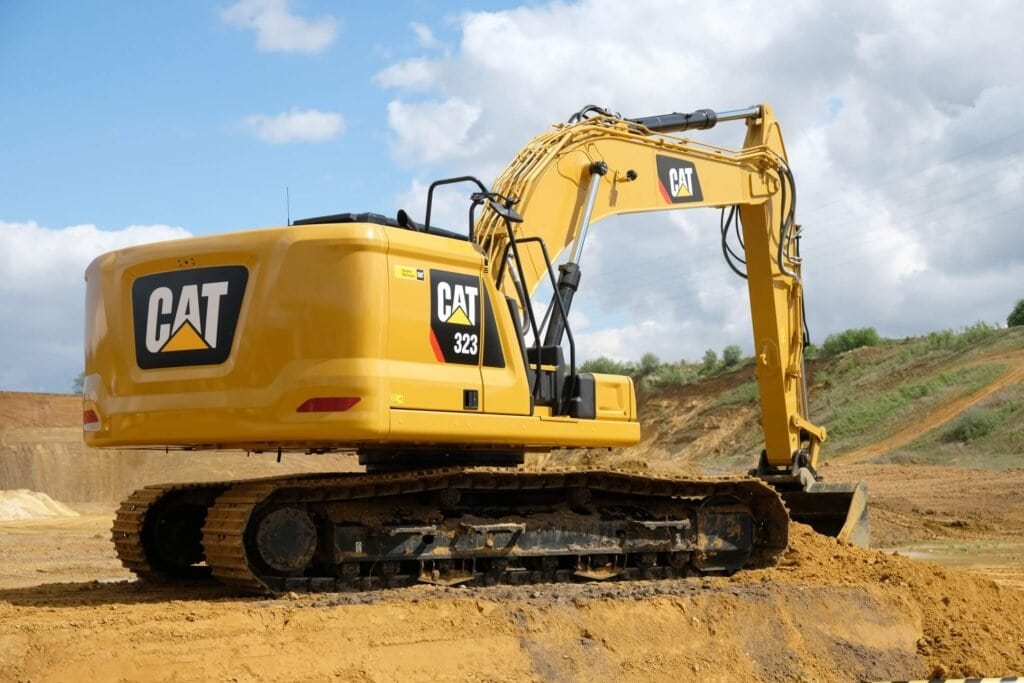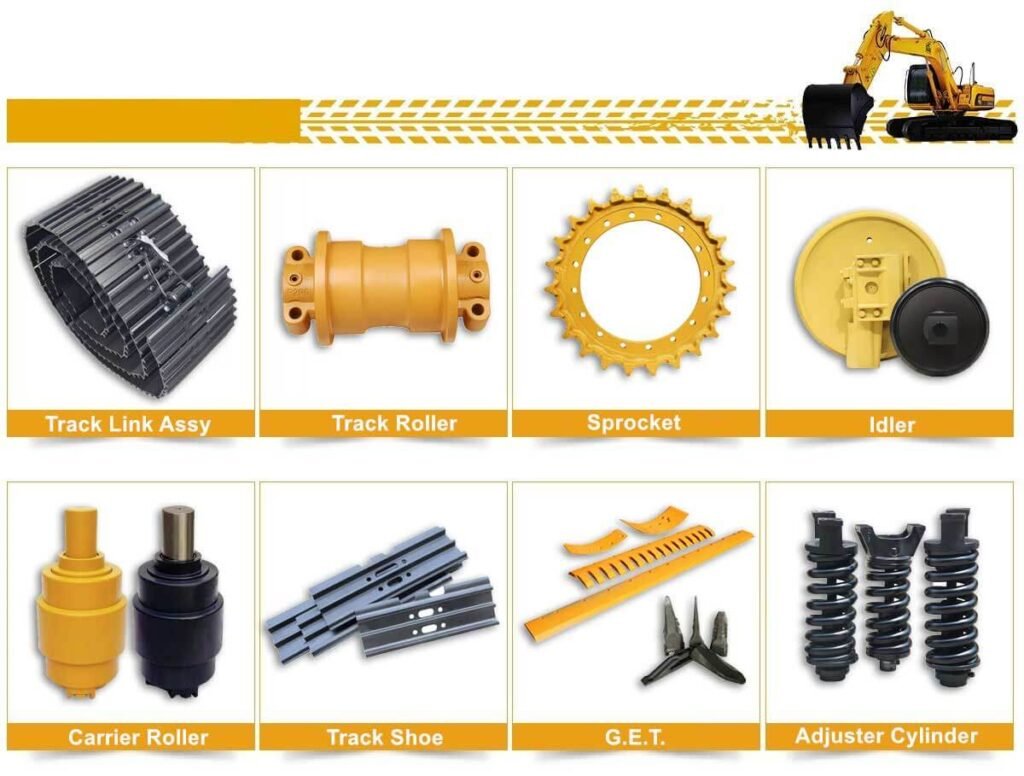1. Introduction:
When you’re using an excavator, you need it to perform reliably in tough conditions, day in and day out. The performance of your machine will seriously deteriorate if excavator undercarriage parts are neglected or wear too quickly. And if you’re dealing with faulty undercarriage parts, you’ll experience downtime, higher maintenance costs, and less productivity on your job.
So, what’s the solution? Knowing how each undercarriage component works and how to maintain it can mean achieving uptime, peak performance, long life, reliability, and lower maintenance costs for your excavator. If you pay attention to these undercarriage maintenance and operation suggestions, you will get hours, fuel economy, and performance from the undercarriage than you expect.

2. Key Components of an Excavator Undercarriage:
The undercarriage is one of the most important parts of the excavator as it supports the entire machine and affects its stability, traction, and ability to maneuver in all kinds of ground conditions. Here are the primary components of an excavator undercarriage that you should pay attention to:
- Tracks:
The tracks are the most visible part of the undercarriage. Tracks are responsible for carrying the weight of the excavator, and they spread the weight out over a larger area. They are made of steel or rubber, and the material and design directly affect the machine’s performance. Tracks are critical for stability and traction, especially when the machine is working in soft or muddy ground.
- Drive Sprockets:
Drive sprockets are responsible for driving the tracks. They transfer power from the engine to the undercarriage and propel the machine. The condition of your drive sprocket is crucial for preventing slippage, and it will ensure the machine moves smoothly and maintains its power.
- Idlers and Rollers:
These components are responsible for keeping the tracks aligned and properly tensioned. Idlers guide the track, and rollers support the weight of the machine. Both need to be maintained regularly to ensure they don’t wear out too quickly and cause the tracks to come off the rails.
- Track Chains:
Track chains work with the sprockets and idlers to move the machine. They are made of high-strength steel and are constantly under tension. If the chains are damaged, your excavator will lose its ability to move properly, which will seriously hinder its performance.

3. How Undercarriage Parts Affect Performance:
Every part of the undercarriage is critical to the overall performance of the excavator. If one of these components
becomes damaged or worn, it can have a domino effect on the entire machine.
- Maneuverability:
A well-maintained undercarriage allows for smooth movement, even in challenging environments. However, if your tracks, rollers, or sprockets are worn, the excavator may struggle to move through soft terrain or loose ground. This reduces your ability to complete tasks efficiently, particularly on construction sites with uneven or unstable soil.
- Stability:
The undercarriage is very important for the stability needed when lifting heavy and digging. Damaged or worn parts can tremendously affect the balance of the machine, possibly causing tipping, especially during side-sloping or backfilling. The undercarriage components need to work together to help maintain the stability of the machine throughout its various tasks.
- Долговечность:
Wear on the undercarriage components is normal, but not maintaining them will lead to machine and component failure. A failed undercarriage is expensive. It will require new tracks or other expensive components. Simply watching and knowing the condition of the undercarriage can save you thousands of dollars in the long run.

4. Factors Affecting Undercarriage Performance:
While the undercarriage components themselves are designed for durability, several factors affect their performance over time:
- Soil and Terrain:
The type of soil and work being done dramatically affects the wear on the excavator’s undercarriage. If the machine is being used in very muddy, rocky, or soft ground conditions, the pressure on the undercarriage drastically increases, causing the components to wear much faster. It is important to choose the correct machine for the job to ensure you do not damage the undercarriage.
- Operating Conditions:
Long-term use in severe applications, such as carrying heavy loads or severe ground conditions, will wear out the undercarriage sooner. Machines used for severe applications, such as demolition or long-reach digging, need to have the undercarriage inspected more often. Overloading the machine or working in severe applications will wear out the components faster.
- Maintenance Practices:
One of the leading causes for premature undercarriage failure is neglect. Not taking the time to maintain and inspect the undercarriage will cause you to have premature failures. Simple things like keeping the tracks clean, greasing the rollers, and checking the track tension will make your undercarriage last.

5. How to Maintain Excavator Undercarriage Parts:
Maintaining your excavator’s undercarriage components is essential to ensuring that they perform at their best. Here are some key tips to keep your undercarriage parts in top shape:
- Regular Inspections:
Inspect your undercarriage routinely for wear or damage. Look for things like uneven wear on the tracks, loose parts, or excessive wear on the rollers and sprockets. Find problems early before they cause other problems.
- Proper Track Tension:
Maintain the undercarriage tight so the undercarriage does not bounce or create excessive vibration that damage parts. If the track is too loose, it will slap and stretch the components, causing them to wear out faster. If the track is too tight, it will cause the drive motors, idlers, and rollers to wear out prematurely.
- Cleaning and Lubrication:
Clean the undercarriage regularly to remove dirt, debris, and mud, which can cause unnecessary wear on the tracks and rollers. Lubricate the moving parts to minimize friction and prevent corrosion. Keeping your undercarriage clean and well-lubricated will help extend its life.
- Use the Right Type of Tracks:
Select the right type of track for your working conditions. If you’re operating on rough or rocky terrain, consider using heavy-duty tracks that are designed to withstand high levels of stress. Choosing the right tracks for your specific environment will minimize the risk of damage.

6. How to Minimize Downtime Through Undercarriage Maintenance:
Minimizing downtime is essential for maintaining productivity on any construction project. One of the best ways to achieve this is by keeping the undercarriage in top condition. Here are some practical steps you can take:
- Scheduled Inspections:
Set up a regular time to inspect the undercarriage for abnormal wear on the components. Depending on your application and underfoot conditions, it could be once a month or once a quarter. Inspect the condition of the tracks, rollers, sprockets, and idlers. If you find a problem, fix it before it damages other parts of the undercarriage.
- Proper Storage:
When your excavator isn’t in use, make sure it’s stored correctly. Storing the machine in a dry, sheltered area helps prevent rusting and damage to the undercarriage components. If the machine is left outside, debris and moisture can accumulate on the undercarriage, accelerating wear.
- Track Monitoring Technology:
Many modern excavators come equipped with sensors or monitoring systems that allow operators to track the condition of the undercarriage in real-time. These systems can alert you to issues such as uneven track tension or misalignment, enabling quicker action to prevent major failures.

7. How Undercarriage Parts Contribute to Overall Cost Efficiency:
Maintaining a healthy undercarriage doesn’t just affect performance; it’s directly linked to the overall cost-efficiency of your excavator. A well-maintained undercarriage can reduce repair costs and increase the machine’s resale value. Here’s how:
- Lower Repair Costs:
Preventive maintenance on the undercarriage is typically far less expensive than replacing major components like the tracks or sprockets. Regular cleaning, tensioning, and lubrication will keep wear at bay and ensure that parts last longer, reducing the frequency of expensive repairs.
- Extended Machine Life:
A well-maintained undercarriage extends the lifespan of the excavator as a whole. With the undercarriage in good shape, other machine components such as the engine, hydraulics, and electrical systems also face less strain. This holistic approach to maintenance increases your excavator’s longevity and reduces long-term operating costs.
- Resale Value:
If you plan to sell your excavator in the future, a machine with a well-maintained undercarriage will have a higher resale value. Buyers are more likely to pay a premium for a machine with a strong, reliable undercarriage, as it signals the overall health of the equipment.
8. Understanding the Role of Undercarriage in Fuel Efficiency:
The condition of your excavator’s undercarriage can also affect fuel consumption. A damaged or poorly maintained undercarriage can make the machine less efficient and increase fuel usage. Here’s how:
- Increased Resistance:
Worn tracks or misaligned rollers increase rolling resistance, meaning the engine has to work harder to move the machine. This added strain on the engine can cause higher fuel consumption, reducing overall efficiency.
- Improper Track Tension:
Overly tight tracks create unnecessary friction, while tracks that are too loose can cause uneven wear. Both situations lead to a less efficient machine that requires more fuel to complete tasks.
- Effect on Overall Performance:
When the undercarriage is in poor condition, the excavator may not perform as smoothly, leading to inefficient operation. For example, if the tracks are not in optimal condition, it can slow down the movement of the machine, making digging and hauling tasks take longer, which in turn consumes more fuel.

9. The Impact of Undercarriage on Safety:
Lastly, a well-maintained undercarriage isn’t just about performance—it’s also about safety. A malfunctioning or damaged undercarriage can lead to unsafe working conditions that put both the operator and other workers at risk. Here’s how:
- Risk of Accidents:
Worn-out tracks, damaged rollers, or a misaligned undercarriage can make the excavator more difficult to control, increasing the risk of accidents. For example, a compromised undercarriage could cause the machine to tip or get stuck, leading to dangerous situations on site.
- Operator Visibility and Control:
A malfunctioning undercarriage may also affect the operator’s ability to control the machine effectively, especially on uneven ground. Reduced stability and traction could cause the machine to veer off course, leading to accidents, especially in tight workspaces.
- Prevention of Serious Failures:
Regular maintenance and inspection can prevent catastrophic failures such as tracks falling off, roller breakdowns, or sprocket malfunctions. Such failures not only cause significant downtime but can also create hazardous situations for the operator.
10. Conclusion:
In conclusion, the excavator undercarriage is an essential component that directly impacts performance, durability, and safety. Its condition can influence everything from machine efficiency and fuel consumption to safety on the job site. By taking the time to maintain, inspect, and repair the undercarriage regularly, you’ll increase your excavator’s lifespan, minimize downtime, and reduce overall operating costs. Whether you’re dealing with harsh terrain, heavy loads, or long working hours, ensuring that your undercarriage remains in top condition is critical for getting the most out of your excavator and keeping your operations running smoothly.